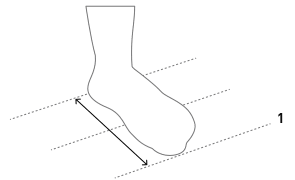Crocs Size Converter & Sizing Guide
Easily find your perfect Crocs fit. Our converter handles US, EU, UK, and CM sizes, plus get expert insights on fit types, comfort, and popular styles.
Enter size to see conversion results instantly
Crocs Men's Size Chart
| US | UK | EU | CM |
|---|---|---|---|
| 4 | 3 | 36-37 | 22.1 |
| 5 | 4 | 37-38 | 22.9 |
| 6 | 5 | 38-39 | 23.8 |
| 7 | 6 | 39-40 | 24.6 |
| 8 | 7 | 41-42 | 25.5 |
| 9 | 8 | 42-43 | 26.3 |
| 10 | 9 | 43-44 | 27.2 |
| 11 | 10 | 45-46 | 28.0 |
| 12 | 11 | 46-47 | 28.8 |
| 13 | 12 | 48-49 | 29.7 |
| 14 | 13 | 49-50 | 30.5 |
| 15 | 14 | 50-51 | 31.4 |
| 16 | 15 | 51-52 | 32.3 |
| 17 | 16 | 52-53 | 33.1 |
Crocs Sizing Insights: Find Your Perfect Fit
Crocs are known for their unique comfort. Use our guide to find the perfect fit and understand the different styles and sizes.
Quick Sizing Tips
Roomy Fit Philosophy
Most Crocs offer a generous fit. Consider going down a half size if you prefer a snugger feel.
Utilize the Heel Strap
For a more secure fit, especially during active wear, push the heel strap forward into "sport mode".
Croslite™ Comfort
Crocs' proprietary material adapts to your foot over time for custom comfort.
Consider Activity Type
Classic clogs are roomy; LiteRide and slides offer slightly more contouring.
Width Consideration
Crocs naturally have wide footbeds; usually no need for wide sizing.
First-Time Buyers
Try your normal sneaker size; adjust half a size if you prefer snug fit.
Key Adult Crocs Styles & Fit Considerations
Classic Clog
Features:
Iconic Croslite™ foam, ventilation holes, heel strap.
Fit:
Roomy, relaxed fit. Heel strap can be flipped back for extra stability.
Size Tip:
True to size is usually perfect; half a size down for a snugger feel.
Best For:
Everyday casual wear, gardening, around the house.
LiteRide Clog
Features:
Softer LiteRide™ foam for cushioned comfort, modern sporty look.
Fit:
Slightly more structured than Classic.
Size Tip:
True to size works; wide-footed wearers may still find them comfortable.
Best For:
Walking, casual outings, or work environments where comfort is essential.
Sandals & Slides
Features:
Open-toe or slide designs, lightweight, water-friendly.
Fit:
More flexible; usually very forgiving.
Size Tip:
True to size is standard; wide-footed users can use the same size.
Best For:
Beach, pool, casual summer wear.
Work / Bistro
Features:
Non-slip, closed-toe designs with enhanced foot support.
Fit:
Slightly more structured for safety and support.
Size Tip:
True to size for most; ensure room for socks if needed.
Best For:
Healthcare, hospitality, or any environment requiring long hours on feet.
Winter / Boot Styles
Features:
Faux-fur lining, insulated, Croslite™ base.
Fit:
Roomier to allow for socks.
Size Tip:
True to size or half size up for thicker socks.
Best For:
Cold-weather casual wear or outdoor activities.
Tips for Choosing the Right Crocs Size
Consider Activity
Classic clogs are roomy; LiteRide and slides offer slightly more contouring.
Width
Crocs naturally have wide footbeds; usually no need for wide sizing.
First-time Buyers
Try your normal sneaker size; adjust half a size if you prefer snug fit.
Heel Strap Usage
Flip it back for secure fit, forward for casual slip-on comfort.
Foot Swelling
If you'll be standing or walking long hours, true size or half a size up is safest.
Understanding Crocs Fit Types
Crocs Comfort Levels
Original Croslite™ foam cushion: Feels soft with all-day support.
Deep cushion: Feels soft with all-day support.
Our most cushion: pillow-top, sink-into-it softness with all-day support.
How to Accurately Measure Your Feet for the Best Fit
To ensure the most accurate shoe size conversion, understanding your precise foot measurement data is crucial. Please follow these simple steps:

Tip
It is recommended to measure your feet in the evening, as feet may swell slightly during the day due to heat and activity.